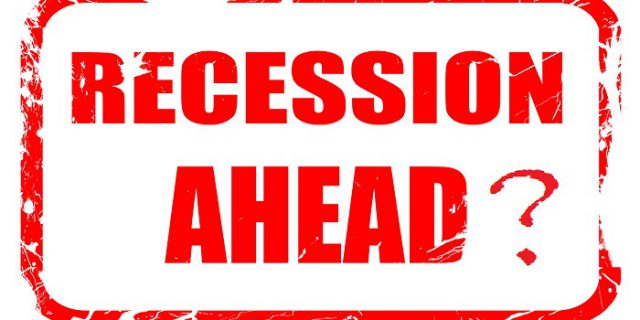Predicting Recessions
There has been much speculation recently about a recession in 2016, so we take a look at what the drivers could be. Are there signals from energy price movements, and how might this impact you.
It would appear that falls in wholesale energy prices, usually triggered by falling demand, present the perfect indication of bad times ahead, and certainly, this has been somewhat true with previous downturns. There are many analysts and commodity pundits who believe that the recent drop in energy commodities are a sure sign that bad times are coming – but do they hold up?
In the chart below, the US recessions of 1990, 2001 and 2007 are indicated, showing the start and end of each recession.

We are currently in the territory after the blue star. Chartists might be predicting recessions based on this, but it is not quite that simple. Where decreasing demand drives previous prices to fall, the recent drop was a result of global overproduction. The recent rise in prices has several factors, not least the reduction in stock levels and production across the US.
This, combined with OPEC talks on possible volume reductions (which in reality never bore fruit) and unplanned outages from several oil-producing nations, has seen WTI lift and hover just under the $50 bbl mark.
Another factor to consider in all this activity is market volatility. Volatility levels in March were the highest since early 2009 when crude oil prices were falling in response to the financial crisis and a drop in demand for petroleum products. The recent decline in oil prices resulted in volatility levels closer to the 2015 average of 27%. The 30-day measure of oil price volatility (calculated as the standard deviation of daily percent changes in crude oil prices over the previous 30 trading days) reached a high of 45% on March 4 before falling to 33% on April 18. Some take this reduction in volatility as an indicator of more certain times ahead.
So how are companies actually performing?
There is some detail here, but it is essential to understand the general health of the economy. After results for the first quarter of this year came in, there were some interesting observations. The blended earnings decline for Q1 2016 is -6.8%. The first quarter marked the first time the index has seen four consecutive quarters of year-over-year declines in earnings since Q4 2008. It also marked the most significant year-over-year decline in revenues since Q3 2009 (-15.7%).
Four sectors have reported or are reporting year-over-year growth in earnings, led by the Consumer Discretionary and Telecom Service sectors. Six sectors have reported or are reporting a year-over-year decline in revenues, led by the Energy, Materials, and Financials sectors. The reduction of 6.8% is better than expectations of 8.8%.
In terms of revenues, 53% of companies have reported actual sales above estimates, and 47% have reported actual sales below estimate. The percentage of companies reporting sales above estimates is above the 1-year (50%) average but below the 5-year average (56%).
The percentage of companies beating Earnings Per Share (EPS) estimates (71%) is above the 5-Year average overall. With 95% of the companies in the S&P 500 having reported earnings to date for the first quarter, 71% have reported actual EPS above the mean EPS estimate. 8% have reported actual EPS equal to the mean EPS estimate, and 21% have reported actual EPS below the mean EPS estimate.
The percentage of companies reporting EPS above the mean EPS estimate is above both the 1-year (69%) average and the 5-year (67%) average.
At the sector level, the Consumer Staples (85%), Materials (85%), and Health Care (82%) sectors have the highest percentages of companies reporting earnings above estimates. In comparison, Energy (53%) and Utilities (55%) sectors have the lowest percentages of companies reporting earnings above estimates.
The earnings surprise percentage (+4.2%) is equal to the 5-year average in aggregate. Companies are reporting earnings, that are 4.2% above expectations. This surprise percentage is equal to both the 1-year (+4.2%) average and the 5-year (+4.2%) average.
The market has rewarded upside earnings surprises less than average and has also punished downside earnings surprises more than average during this earnings season.
So what does it all mean when predicting recessions?
In regular times, an emerging market panic, a drop in oil prices, and a strengthening dollar doesn’t matter much to the United States. In 1998, for example, all of those things were happening, yet growth roared ahead in 1999.
But if there’s a recession in 2016, it will be because of two crucial differences in the economy.
First, the starting point for the United States and other advanced economies was much stronger back then. From 1996 to 1998, the United States economy grew an average of 4.3 percent a year; from 2013 to 2015, the rate was less than half that, 2.1 percent. A much smaller hit to growth would be more likely to put us in the recessionary territory now than in the late 1990s.
That lower economic starting point could already be having some psychological impacts that slow growth. Perhaps the weak underlying condition of the United States economy is a reason consumers are mainly putting their savings from lower energy prices into increased savings rather than buying stuff. In the late 1990s, they felt more confident, and thus cheaper oil was more of an economic boom. If you’re a corporate chief executive making plans to expand your business, surely similar dynamics apply.
So what are we to make of all this? What is the forecast, and how can we plan?
The oil market is seeing a climb from the abyss, but there will still be pressure from OPEC. Producers with a much lower cost of production like Saudi Arabia will want to see oil stay below the $70 to $80 bbl level needed by US producers. This will maintain its market share until strong economic growth returns and demand increases once again.
While oil and natural gas prices have decoupled in recent years due to the enormous shale discoveries, the downturn in rig counts is beginning to eat away at the oversupply. By November 2016, this and an increasing appetite for natural gas generation and exports should lift prices once again, which are already up significantly from March.
Large energy consumers will need to keep a very close eye on how they manage their energy costs. Commodity price spikes can dramatically impact earnings, requiring an enormous uplift in sales to maintain the status quo, challenging in a sluggish market.
Predicting recessions requires multiple inputs from many different sources. While we don’t know for sure what is around the corner, the key to an auspicious energy and utility program is flexibility and pragmatism. Organizations should always be able to alter positions to take advantage of any opportunities recessions dynamically can bring. To manage energy commodities, a reliable, independent source of information combined with solutions developed specifically to handle these types of dynamics is critical. It will undoubtedly define the corporate winners and losers over the next 12 months.
Vervantis provide energy and sustainability expertise, outsourced, and on-demand. Specializing in energy price risk management, procurement, utility bill processing, and sustainability software, we have all the tools needed to navigate volatile markets, whether you’re predicting recessions or not. Understand who we work with here or contact our team to learn more about recession-busting utility strategies.











